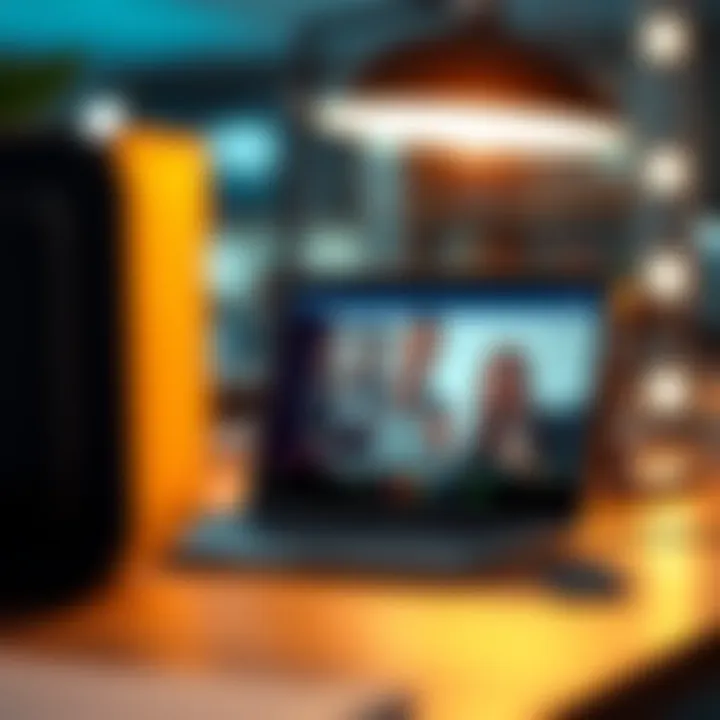Mastering Facebook Live: A Complete Business Guide


Intro
As the digital marketplace evolves, engaging with your audience has never been more paramount. Facebook Live emerges as a powerful tool that allows businesses to broadcast in real-time directly to their followers. By utilizing this feature effectively, companies can create a more intimate connection with their customers, allowing for instant feedback, interactions, and building community.
In this guide, we will demystify the intricacies of hosting a live event from your Facebook Business Page. Our approach encompasses the preparation phase, execution, ongoing engagement strategies, and actionable follow-up tactics. Throughout this journey, we aim to equip entrepreneurs – be they fledgling startups or seasoned businesses – with the knowledge to optimize their live broadcasts for maximum impact.
Moving along, we will explore Effective Sales Strategies that align seamlessly with the goal of going live, enhancing the broadcast's potential to drive sales conversions. Following that, the integration of relevant trends in business-sales and CRM will be highlighted, recognizing how technology shapes our connection with audiences.
Whether you're aiming to launch a new product, hold a Q&A session, or share industry insights, this guide will illuminate the path from preparation to execution and evaluation, ensuring that each step brings you closer to cultivating an engaged and loyal customer base.
Understanding Facebook Live
Going live on Facebook is more than just hitting a button and broadcasting to the world; it’s a significant milestone in how businesses interact with their audience. Understanding Facebook Live is crucial because it not only offers an avenue for real-time engagement but also enhances authenticity and transparency in communication.
Defining Facebook Live
Facebook Live is a feature that allows users to broadcast live video to their followers in real-time. This tool is available on Facebook Business Pages, making it especially valuable for companies wishing to create a more direct connection with their customers. When you go live, viewers can comment and interact with you in real-time, fostering an environment that feels immediate and personal. This sets Facebook Live apart from traditional video content, where interactions are often delayed.
Among the myriad of social media tools, Facebook Live stands as a beacon for businesses. It's not merely an engagement tool; it's a way to cultivate a community and stimulate conversation. As people become increasingly drawn to dynamic content, Facebook Live serves as a powerful platform for storytelling, behind-the-scenes tours, Q&A sessions, and product demonstrations.
The Importance of Live Streaming
The importance of live streaming cannot be overstated. In a world that values instantaneous responses and authentic interactions, live streaming is a splendid way to accomplish both. Here are some key benefits:
- Increased Engagement: Live events typically enjoy higher engagement rates compared to pre-recorded content. Viewers are more likely to comment, share, and interact while something is happening in real-time.
- Authenticity: Broadcasts help businesses present themselves sincerely. Audiences often perceive live streams as more genuine, which can bolster trust.
- Wider Reach: Facebook algorithms tend to favor live content, resulting in increased visibility and potential reach. This could translate into more followers and increased brand loyalty.
- Immediate Feedback: Hosting a live session allows businesses to receive instantaneous reactions, understand customer sentiments, and modify their strategies accordingly.
"Live streaming creates opportunities for businesses to connect with audiences in ways that pre-recorded content simply cannot."
As such, businesses must look beyond conventional marketing methods and engage with their audience in this new, vibrant way. Understanding the nuances of Facebook Live will undoubtedly set the groundwork for marketers and entrepreneurs aiming to leverage their digital presence effectively.
Prerequisites for Going Live
Understanding what you need before hitting that live button is crucial. Think of it like prepping before a big exam; without the right setup, you might just end up with a messy, disorganized broadcast that doesn't resonate with your audience. Here’s a closer look at what you need to get your Facebook Live session off the ground smoothly.
Setting Up Your Business Page
First and foremost, your Facebook business page needs to be in tip-top shape before going live. It's more than just pressing a button and starting a stream. Your page should reflect your brand identity and be fully optimized to attract your desired audience.
- Complete Profile: Ensure your page has a professional profile and cover photo, a well-written description, and updated contact information. When potential viewers see a polished page, they are more likely to tune in.
- Engagement Strategies: Regularly post updates or engaging content to build momentum. This will help inform your followers about your upcoming sessions, stirring up interest and anticipation.
All these elements not only enhance your live performance but rouse curiosity and encourage users to engage with your content.
Technical Requirements
Now, let’s talk tech. This part can be a bit daunting, but isn't rocket science. Familiarity with the technical aspects can mean the difference between a professional broadcast and a haphazard one. Here’s what you need to focus on for a seamless experience.
Internet Connectivity
First up is internet connectivity. You could have the coolest content ever, but if your connection is wobbly, your audience will likely bounce away faster than a rubber ball. Ideally, a wired Ethernet connection is a great choice due to its reliability. This is critical, especially when trying to attract an engaged audience. Wi-Fi can be unpredictable, and even a minor glitch could lead to frozen frames or dropped audio.
- Key Characteristic: A wired connection tends to offer more stability compared to wireless options, minimizing interruptions during vital moments of your broadcast.
- Unique Feature: Consider using a speed testing tool to ensure you have sufficient upload speed for smooth streaming. Aim for at least 3 Mbps, though higher speeds are better for quality.
Camera and Mic Setup


Next, camera and mic setup can have a substantial impact on how you're perceived on screen. Imagine trying to communicate in a crowded room; if people can’t hear you clearly, they lose interest quickly. Good audio quality means your audience doesn’t have to strain to catch what you’re saying, leading to better overall engagement.
- Key Characteristic: A decent camera can greatly enhance video quality, making your broadcast look more polished and professional. Consider using a DSLR or a dedicated webcam for an edge.
- Unique Feature: A good microphone is just as crucial. An external microphone will often produce much clearer sound than your built-in laptop mic. Options like the Blue Yeti or Audio-Technica AT2020 are popular because they provide excellent quality at a reasonable price.
Software Tools
Finally, choosing the right software tools can give you a layer of control over your live streaming. You could go for Facebook's native live streaming option, but isn’t it better to have a bit of flexibility?
- Key Characteristic: Streaming software like OBS Studio or StreamYard can provide additional features, such as overlays and graphics, allowing for a more engaging viewer experience.
- Unique Feature: They also enable multi-streaming, which allows you to go live on multiple platforms simultaneously, maximizing your reach.
In sum, don’t overlook the prerequisites before launching into your live broadcast. Each element, from internet stability, camera, and microphone quality to the right software tools, contributes to a successful and engaging experience. If you take the time to get these components right, your audience will appreciate the effort and come back for more.
Remember, a well-prepared live session can convert viewers into loyal customers. Don’t rush the essentials!
Preparing for the Live Session
Preparing for a live session on Facebook is akin to laying the groundwork for a successful performance. This phase is critical because it not only sets the tone for the broadcast but also determines how well your message is communicated and perceived. Being well-prepared might be the difference between a casual chat and a captivating event that keeps your audience glued to their screens. Several elements come into play, each with their own importance in setting the stage for a dynamic live interaction.
Choosing the Right Time
Timing can shape the success of your live stream more than you may initially think. It’s all about finding that sweet spot when your audience is most receptive to engaging with your content. Consider your target demographic's habits: for instance, if you’re aiming at busy professionals, evenings or weekends might work best. Keep an eye on your Facebook Insights to spot trends in when your followers are most active. Picking the right moment could amplify your viewership significantly, so don’t skimp on this step. Do a little homework and consider external factors like holidays or special events that might influence engagement.
Content Planning
An effective content plan isn't just useful; it’s essential when prepping for a live session. The danger of winging it usually leads to a disjointed presentation that may confuse your viewers. Instead, plotting out your points creates a roadmap for what you want to cover and guides your flow. Doing this effectively can also provide comfort, knowing that you have your talking points set. Let’s look at the keys to successful content planning:
Outlining Key Points
Outlining key points gives structure to your live session. This is where you decide what you will discuss and the order to follow while doing it. This approach helps keep you on track and reduces anxiety. The beauty of outlining is that it allows flexibility; should an audience question arise, you can smoothly adapt without losing your flow. It’s a practical tool that smart professionals favor. A well-structured outline can also assist in making your objectives crystal clear.
Visual Aids and Props
Visual aids and props can elevate your live broadcast from mundane to vibrant. Whether it’s slides, charts, or simple physical items, incorporating visually appealing elements can help maintain attention. They serve not only to illustrate your points but also to break the monotony of plain talking heads. However, you should keep in mind that overcomplicating your visuals might distract or confuse viewers. Aim for balance; props should support your narrative rather than overshadow it.
Engagement Elements
Integrating engagement elements can transform a one-way broadcast into a two-way conversation. In this age of digital communication, people crave interaction. Asking questions, running polls, or even conducting giveaways during your session can spark interest and boost live participation. Think of it like a dialogue rather than a monologue; this approach invites viewers to invest not only their time but their attention as well. If used smartly, engagement strategies can lead to higher retention rates and even convert viewers into loyal customers by making them feel a part of the experience.
In summary, preparation is not merely a task; it’s a multi-faceted strategy that shapes your outreach on Facebook. By choosing the right time, planning content carefully, and incorporating enticing visuals and engagement elements, you can provide your audience with a live experience that’s enlightening and memorable. Don't be caught flat-footed; approach these preparations with the significance they deserve.
Executing the Live Stream
Executing the live stream is a crucial phase in the process of going live from your Facebook Business Page. This segment serves as the culmination of preparation and planning efforts, where everything comes together. Successful execution not only entails starting the broadcast; it’s also about engaging with the audience effectively during the session. The importance of this step cannot be overstated, as it directly impacts how your message is received by your viewers, shapes their experience, and ultimately influences future interactions with your brand.
As any salesperson or entrepreneur knows, first impressions matter immensely. The way you kick off your live stream sets the tone for the entire session. Therefore, having a solid starting strategy can lead to better engagement rates and create a positive atmosphere for your audience. Once the show is rolling, maintaining interaction keeps viewers invested and connected. Engaging your audience throughout the live session ensures that they feel valued and part of a community, which can be significant in fostering brand loyalty.
Starting the Live Broadcast
Starting your live broadcast is like opening the curtains on a grand stage. This moment is about capturing the audience’s attention right from the get-go, ensuring they want to stick around for what's next. One of the techniques often utilized here is to greet viewers warmly and introduce yourself and the purpose of the broadcast clearly. A quick rundown of what to expect—the topics you’ll cover, potential audience participation, and even a brief mention of any special announcements—can set the stage effectively.
Moreover, technical readiness is key. Before hitting that "go live" button, confirming that your camera and audio are functioning well ensures a smooth start. Poor sound or picture quality can lead viewers to click away in seconds, so take the time to test everything ahead of the actual broadcast.
Engaging the Audience


Engagement during your live stream is what helps keep the momentum going. The last thing you want is for your audience to feel like they are merely watching a show rather than participating in a conversation. Harnessing various engagement techniques can provide depth and allow for interaction, turning passive viewers into active participants.
Response to Comments
Responding to comments in real-time is one of the strongest methods of audience engagement. This action demonstrates that you value viewers’ opinions and contributions, creating a two-way dialogue. A relatable approach can turn a simple "hello" from a viewer into a rich interaction. This not only makes your audience feel seen but also encourages others to join the fray, elevating the overall atmosphere of the broadcast.
One important thing to remember is to acknowledge not just the questions but also any accolades being thrown your way. Leaving no comment unattended speaks volumes about your willingness to interact. But there’s a balancing act involved—while engaging with comments, ensuring your flow of content remains steady is just as vital. Too much distraction can derail your key messages.
Call-to-Action
In any business communication, a compelling call-to-action is vital, and live streams are no exception. Ending segments or the entire broadcast with a clear directive—be it encouraging viewers to visit your website, sign up for a newsletter, or engage in online discussions—can lead to heightened post-stream activity. Fusing urgency with value often leads to better conversion rates as viewers can feel they are missing out on something beneficial if they don’t take action.
Moreover, mentioning this at various points during the session can reinforce that message, serving as a consistent reminder. The key characteristic here lies in crafting it to be engaging, steering viewers towards desired outcomes without sounding overly pushy—after all, you want them willing to act on their own accord.
Interactive Elements
Incorporating interactive elements during your live stream can significantly enhance audience engagement. Polls, questions, or even fun quizzes can break the ice and lure viewers to participate. This provides an electric atmosphere and helps to dictate the flow of the broadcast. For instance, asking open-ended questions can lead to diverse viewpoints that enrich the discussion.
These interactive features create a more immersive experience, inviting viewers not just to watch but to feel as though they are part of an active community. While these elements are easy to implement using various live-streaming tools, it’s essential to strike a balance. Overdoing them can make the stream feel gimmicky rather than authentic, which might dissuade viewers from fully engaging.
In summary, executing the live stream correctly can either elevate or detract from all the hard work put into preparation. By carefully crafting how you start, intertwining audience engagement through responses, calls to action, and interactive elements, you are setting the stage not just for the current live session but for the future relations with your viewers. As the proverbial saying goes, "actions speak louder than words," and this rings particularly true in the world of live streaming where interaction is integral.
Post-Live Strategies
In the world of live streaming, the moment your broadcast ends doesn't mean your work is finished. Post-live strategies are essential for maximizing the impact of your session. Engaging with your audience doesn’t stop when the camera turns off; instead, it's a pivotal opportunity to nurture relationships and harness the momentum you’ve built. By analyzing performance metrics and refining content for future use, you significantly enhance your ability to reach and connect with your audience over time.
Analyzing Live Performance
Assessing how your broadcast went is crucial. Understanding audience reactions and interactions helps tailor future sessions to better serve your audience.
Viewership Metrics
When we talk about viewership metrics, we’re diving into data that shows how many people tuned in during your live stream. Knowing the view count gives you a clear indicator of your reach - the more eyes on your content, the better!
The key characteristic of viewership metrics is that they provide quantifiable evidence of reach. This makes it a valuable tool for assessing the success of your live stream strategy. For instance, if you notice a steady increase in viewership over several sessions, it indicates that your audience is growing.
A unique feature of viewership metrics is that they can help identify the best time for your audience to engage with your content. By tracking when live viewers peak, you can strategically plan your future broadcasts for maximum exposure. However, be mindful; high numbers alone don’t tell the full story. You must pair these insights with engagement data to form a complete picture of your live performance.
Engagement Rates
Engagement rates take things a step further. Unlike simple view counts, this metric shows how actively your audience is interacting with your content, such as likes, comments, and shares during the live session. This is where the real magic happens. High engagement rates can convert viewers into loyal customers.
The distinct advantage of engagement rates lies in their ability to illustrate audience sentiment. A lively chat and lots of reactions can indicate that you've struck a chord with your audience. This feedback can inform your content strategy, making it a beneficial approach for refining your future broadcasts.
But here lies the rub: high engagement with fewer viewers may also suggest a niche audience. While that’s great for focused content, think about ways to broaden your appeal for future sessions. What’s the right balance? Keep analyzing and adjusting to find what works best.
Reusing Live Content
Once your live session is wrapped, don’t let it sit idle; instead, reuse live content to get the most bang for your buck. This technique doesn’t just save time, it maximizes your investment in live broadcasting.
Creating Snippets
Creating snippets involves taking key moments from your live stream and repackaging them into shorter clips. Think of it as distilling your live content down to its essence for easy digestion. These snippets can be shared across your social media platforms, drawing in new viewers who might not have tuned in during the live event.


The key characteristic of creating snippets is that it allows you to highlight the most engaging parts of your session. This flexibility makes it an attractive strategy. By offering bite-sized content, you help your audience find value quickly without committing to an entire hour-long broadcast.
However, take caution; not every moment will shine as a snippet. You must carefully select content that resonates with your audience to maintain interest and provide real value.
Developing Related Content
Another effective way to extend your live stream’s life is by developing related content. This can encompass blog posts, infographics, or even follow-up videos tailored around the subjects you covered during the live event. By elaborating on themes discussed in your broadcast, you create a richer experience for your audience.
Developing related content is beneficial because it helps reinforce your message. For your audience, having a multimodal approach to the same topic means they can engage with your brand in different ways, catering to their learning preferences.
The unique feature of this strategy is your ability to SEO-optimize all forms of content, thereby reaching a wider audience. Though, bear in mind, creating related content requires a certain investment in terms of time and resources, so weigh your options wisely.
The effort you put into post-live strategies can significantly impact overall audience engagement and conversion rates.
Addressing Challenges
In the digital realm, challenges are an unavoidable part of the journey. When it comes to live streaming on Facebook, entrepreneurs must remain vigilant in recognizing and addressing potential pitfalls. It’s not just about hitting that ‘Go Live’ button—it's about ensuring a smooth experience for both you and your viewers. Challenges can come in many forms, and preparing for them can mean the difference between a successful broadcast and a session that leaves your audience wanting more.
Navigating through these challenges effectively can lead to improved audience retention, enhanced engagement, and ultimately, a stronger brand reputation. Let’s look at some critical aspects to consider.
Technical Difficulties
Technical hiccups can spiral into major setbacks at the most inconvenient times. Imagine your audience tuned in, expecting engaging content, and instead, they see a frozen screen or hear audio echo. These technical glitches often stem from internet issues or equipment failures. Thus, knowing how to troubleshoot these common problems can save your live session.
- Internet Connectivity: Your live stream hinges on a solid connection. For many, relying on a Wi-Fi signal can be risky. Consider using a wired connection for stability. Also, be aware of your internet speed; a slow connection can severely affect video quality.
- Equipment Setup: The right camera and microphone can elevate your broadcast. Check your devices beforehand, ensuring both are functional and compatible with your streaming software. It’s helpful to do a test run before the actual event to iron out any issues.
- Software Compatibility: Ensure that your streaming software is up to date. In rare cases, updates can cause challenges if settings are changed. Familiarize yourself with the software to know where to find solutions if things go awry.
Content Delivery Issues
Even if you manage to get past technical difficulties, content delivery holds its own set of challenges. A compelling message that fails to engage can leave your audience disinterested, regardless of the quality of your stream. Navigating these waters requires articulate planning and agility.
- Audience Engagement: Think about how you can engage your audience during your stream. Preparation is key—consider planning interactive elements, such as polls or Q&A sessions. This breaks the monotony and keeps viewers invested in what you’re sharing.
- Clear Messaging: Your value proposition must be clear. Avoid labyrinthine jargon; if your audience can't follow you, you've lost them. Practice articulating your key points succinctly and clearly.
- Flexibility in Delivery: Sometimes, unexpected things happen during a live session. Your audience might throw you curveballs with questions that weren't anticipated. Be prepared to adapt your script and address these inquiries as they come—this can enhance your credibility and connection to the viewers.
"Preparation is the key to success in any live streaming event. A clear understanding of both technical and content delivery challenges can elevate the entire experience for the audience."
In sum, addressing the challenges in live streaming is a multifaceted endeavor. It requires not only the anticipation of technical difficulties but also a grasp on how best to engage and resonate with your audience. By honing your technical skills and refining your content delivery methods, you set the stage for a live stream that captivates rather than frustrates.
For further information on troubleshooting technical issues, you may refer to Facebook's Help Center. Moreover, to explore more about strategies for better content delivery, visit Wikipedia's overview on effective communication.
Ultimately, a proactive approach can help one not merely cope with potential obstacles but also turn challenges into stepping stones for greater audience engagement.
Future Trends in Live Streaming
The landscape of live streaming is continually evolving, and staying ahead of the curve is vital for businesses aiming to harness its full potential. Understanding future trends in live streaming not only helps instill confidence in your live broadcasts but also enhances engagement with your audience. As technology advances and consumer preferences shift, businesses that adapt appropriately can leverage these changes to maximize their impact.
Emerging Technologies
Emerging technologies are at the forefront of reshaping the live streaming experience. Key developments such as augmented reality (AR) and virtual reality (VR) are making waves, creating immersive environments that captivate viewers.
- AR Integration: Businesses can now incorporate AR elements into their streams. This allows viewers to see information and graphics overlaid on the real world, enriching the narrative around products or services. For example, a makeup brand might showcase how different shades of lipstick look on a user’s face directly through the stream.
- AI and Machine Learning: AI tools are enabling more personalized experiences by analyzing viewer preferences and engagement patterns. This could mean tailored content recommendations or real-time adjustments in stream quality based on viewers' internet speed.
- Enhanced Accessibility: Features like live captioning and language translation services are setting a standard for inclusivity. These advancements allow businesses to reach a broader audience while catering to the specific needs of different demographics!
As these technologies develop, businesses have the chance to create more engaging and valuable live content, making the experience much more than just a simple broadcast.
Shifts in Consumer Behavior
The way consumers interact with live content is changing. A greater emphasis on authenticity and community engagement is shaping the types of live streams that flourish. Businesses must recognize these shifts:
- Desire for Authentic Connections: Today's audiences crave genuine interaction. They are drawn to brands that showcase real people and real experiences. Live streaming offers an unparalleled opportunity to humanize a brand and build trust through transparency.
- Increased Viewership of Interactive Content: With the rise of platforms like TikTok, viewers have become accustomed to interactive experiences. Polls, Q&A sessions, and live feedback are becoming integral to successful live streams. Thus, encouraging viewer participation can greatly enhance engagement levels!
- Tendency towards Niche Markets: As preferences diversify, businesses are finding success by targeting niche audiences. Live streams focused on specific topics or communities can create loyal followers and foster a more intimate viewer-brand relationship.
"Engagement is no longer a buzzword; it's now the heart of successful customer-centered strategies."







